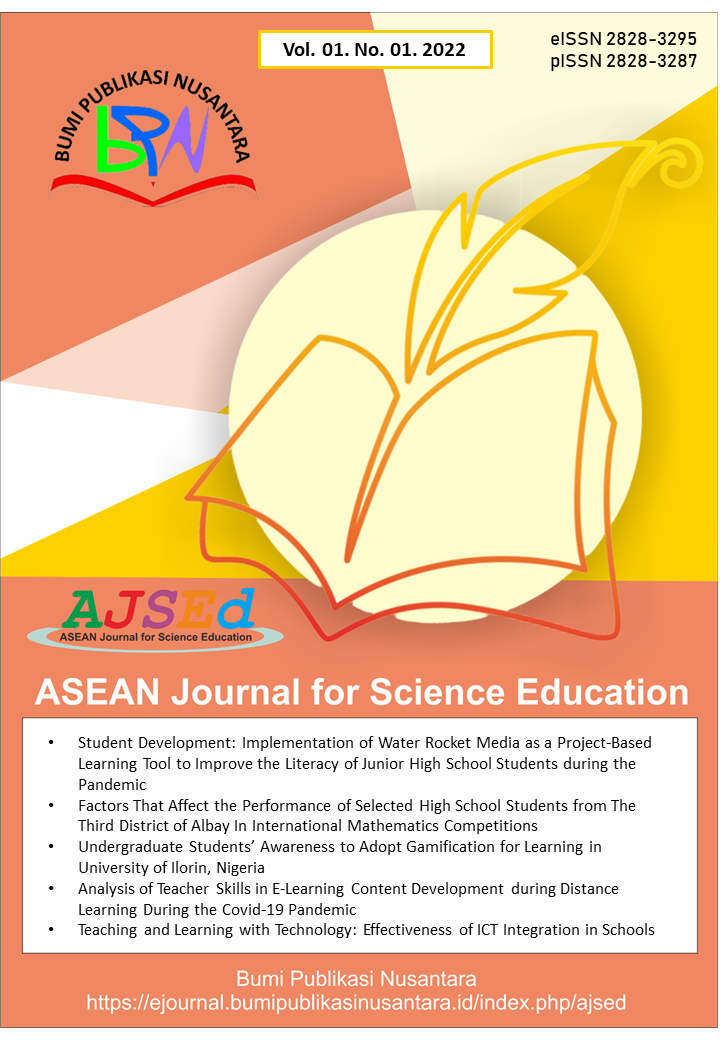Environmental Education: A Tertiary Institution’s Indoor Air Quality Assessment in Nigeria
 ), Sunday Acha(2), Oluwatoyin Arinola Gbotoso(3), Kikelomo Mabinuola Arifalo(4), Susan Omolade Ademilua(5), Lateef Johnson Bello(6), Yemisi Victoria Olayinka(7), Charles Aladesaye(8),
), Sunday Acha(2), Oluwatoyin Arinola Gbotoso(3), Kikelomo Mabinuola Arifalo(4), Susan Omolade Ademilua(5), Lateef Johnson Bello(6), Yemisi Victoria Olayinka(7), Charles Aladesaye(8),
(1) Science and Education Development Institute
(2) Federal University of Technology
(3) Federal College of Agriculture
(4) Bamidele Olumilua University of Education
(5) Federal College of Agriculture
(6) Rufus Giwa Polytechnic
(7) Ijapo High School
(8) Bamidele Olumilua University of Education
 Corresponding Author
Corresponding Author
Abstract
Keywords
References
Abulude, F.O. Fagbayide, S.D., Akinnusotu, A., Makinde5, O.E., Elisha, J.J. (2019). Assessment of the Indoor Air Quality of Akure, South – West, Nigeria. Quality of Life. 10(1-2):15-27. DOI: 10.7251/QOL1901015A
Cai W., Yoshino H., Zhu S., Yanagi U., Kagi N., and Hasegawa K (2015). Investigation of Microclimate and Air Pollution in the Classrooms of a Primary School in Wuhan. Procedia Engineering 121, 415 – 422
Fatima, S., Ahlawat, A., Mishra, S.K., Maheshwari, M., and Soni, V. K. (2022). Variations and Source Apportionment of PM2.5 and PM10 Before and During COVID-19 Lockdown Phases in Delhi, India. MAPAN Journal of Metrology Society of India
Hadei M., Hopke P.K., Rafi ee M., Rastkari N., Yarahmadi M., Kermani M., and Shahsavani A (2018). Indoor and outdoor concentrations of BTEX and formaldehyde in Tehran, Iran: effects of building characteristics of health risk assessment. Environmental Science and Pollution Research. 25:27423-27437
Hassanvand M.S., Naddafi K., Faridi S., Arhami M., Nabizadeh R., Sowlat M. H., Pourpak Z., Rastkari N., Momeniha F., Kashani H., Gholampour A., Nazmara S., Alimohammadi M., Goudarzi G., and Yunesian M. (2014). Indoor/outdoor relationships of PM10, PM2.5, and PM1 mass concentrations and their water-soluble ions in a retirement home and a school dormitory. Atmospheric Environment. 82 (2014) 375-382
Huang, W., Long, E., Wang, J., Huang, R. and Ma, L. (2015). Characterizing spatial distribution and temporal variation of PM10 and PM2.5 mass concentrations in an urban area of southwest China. Atmos. Pollut. Res. 6: 842–848
Kumar, P., Skouloudis, A.N., Bell, M., Viana, M., Carotta, M.C., Biskos, G., and Morawska, L. (2016). Real-Time Sensors for Indoor Air Monitoring and Challenges Ahead in Deploying Them to Urban Buildings, Sci. Total Environ, 2016, 560–561, 150 —159
Meˇciarová L., Vilˇceková S., Burdová E. K., and Kiselák J. (2017). Factors Effecting the Total Volatile Organic Compound (TVOC) Concentrations in Slovak Households. Int. J. Environ. Res. Public Health 2017, 14, 1443; doi:10.3390/ijerph14121443
Munir S (2017). Analysing Temporal Trends in the Ratios of PM2.5/PM10 in the UK. Aerosol and Air Quality Research, 17: 34–48.
Nadalia, A., Arfaeiniab, H., Asadgoldand, Z., Fahiminia, M. (2020). Indoor and outdoor concentration of PM10, PM2.5 and PM1 in residential building and evaluation of negative air ions (NAIs) in indoor PM removal. Environmental Pollutants and Bioavailability, 32(1), 47–55. https://doi.org/10.1080/26395940.2020.1728198
Rivas, I., Fussell, J.C., Kelly, F.J., and Querol, X. (2019). Indoor Sources of Air Pollutants, in Indoor Air Pollution, 2019, pp. 1-34. From Book Series: Issues in Environmental Science and Technology. DOI: 10.1039/9781788016179-00001
Xu G., Jiao L., Zhang B., Zhao S., Yuan M., Gu Y., Liu J., and Tang X (2017a). Spatial and Temporal Variability of the PM2.5/PM10 Ratio in Wuhan, Central China. Aerosol and Air Quality Research, 17: 741–751
Zhang X Y, Arimoto R, Zhu G H, Chen T and Zhang G Y. (1998). Concentration, size-distribution and deposition of mineral aerosol over Chinese desert regions; Tellus B. 50(4) 317–330
Zhou, Y., Cheng, S., Chen, D., Lang, J., Wang, G., Xu, T., Wang, X. and Yao, S. (2015). Temporal and spatial characteristics of ambient air quality in Beijing, China. Aerosol Air Qual. Res. 15: 1868–1880.
Article Metrics
Abstract View : 1401 times
: 1401 times Download : 817 times
Download : 817 times
Refbacks
- There are currently no refbacks.
Copyright (c) 2022 Yayasan Bumi Publikasi Nusantara

This work is licensed under a Creative Commons Attribution-ShareAlike 4.0 International License.







